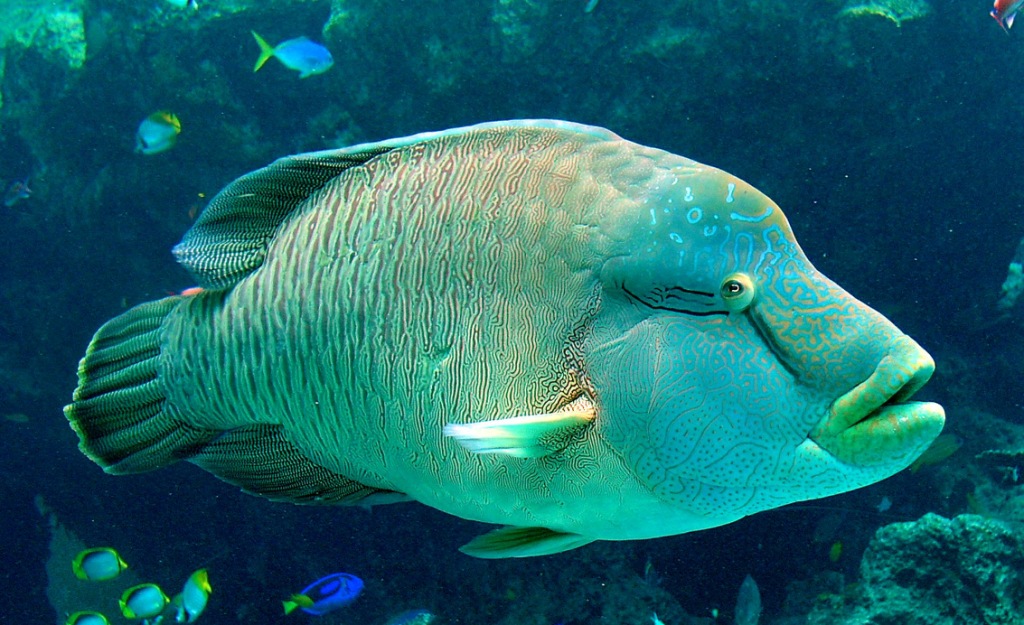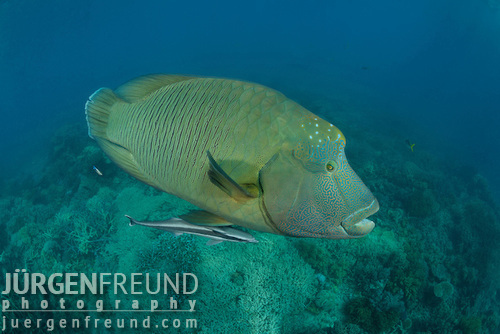Interactions
NAPOLEON WRASSE AS A
PREDATOR:
Interacting with other species is an important feature to every
organism's life. Many times, they interact with each
other in order to obtain food. Every organism belongs to a
food chain and, within this food chain, an organism may be
considered a predator, prey, or sometimes both. Being a
predator means they eat other organisms and, if an organism is
considered prey, then it is being eaten by the predator (Cain et al.
2008). The Napoleon Wrasse is considered both a predator and prey
because it feeds on other animals and other animals feed on it.
In order to survive, it must find its own food. The
typical diet of the Cheilinus undulatus consists of
mollusks, fish,
echinoderms, sea urchins, crustaceans, and invertebrates
(Scales 2005). This enormous fish is also known to eat toxic animals
(Protect 2009)! This means the Napoleon Wrasse is able
to feed on the
crown-of-thorns starfish,
sea hares, and boxfish
even though they contain toxic substances. They are able to
do so because they have thick lips that absorb the
spines of the toxic creatures. They also have strong teeth
in their throats to help break down the hard calcium carbonate
shells of organisms they eat (Shedd 2006).
each
other in order to obtain food. Every organism belongs to a
food chain and, within this food chain, an organism may be
considered a predator, prey, or sometimes both. Being a
predator means they eat other organisms and, if an organism is
considered prey, then it is being eaten by the predator (Cain et al.
2008). The Napoleon Wrasse is considered both a predator and prey
because it feeds on other animals and other animals feed on it.
In order to survive, it must find its own food. The
typical diet of the Cheilinus undulatus consists of
mollusks, fish,
echinoderms, sea urchins, crustaceans, and invertebrates
(Scales 2005). This enormous fish is also known to eat toxic animals
(Protect 2009)! This means the Napoleon Wrasse is able
to feed on the
crown-of-thorns starfish,
sea hares, and boxfish
even though they contain toxic substances. They are able to
do so because they have thick lips that absorb the
spines of the toxic creatures. They also have strong teeth
in their throats to help break down the hard calcium carbonate
shells of organisms they eat (Shedd 2006).
NAPOLEON WRASSE AS PREY:
Although the Cheilinus undulatus is able to survive off
of a variety of organisms, there are still a few organisms that
prey upon them. There aren't many that are willing to prey
upon a large organism, but the ones that are willing to take a
chance are large reef sharks and humans, which are the major
predators of the Napoleon Wrasse. Because this organism is
so large, only large and powerful animals are able to prey on
it, for example, the
sharks
(Bester 2013). Humans, the major predator of
this glorious reef fish, are the reason why the Napoleon Wrasse
is considered "endangered" according to the
IUCN Red List of
Threatened Species (2004). In order to retrive these
large fish, many fishermen fish using cyanide which is very
harmful to not only the ecosystems, but the organisms living
within them as well (Scales 2005). Because of this, humans are regarded as
predators because they enjoy eating the flesh of the fish. It is a luxury item found in several markets in Hong Kong and
can be quite expensive. Sometimes the flesh of this fish
can cost up to one hundred US dollars for one kilogram (Bester
2013)!
 MUTUALISM:
MUTUALISM:
The Napoleon Wrasse is able to form
mutualistic relationships with other organisms within their
environment. A mutualistic relationship is one
where both organism involved benefit (Cain et al. 2008). The Napoleon
Wrasse establishes a relationship with a small remora fish, which
is called a "cleaner," who remove parasites and other harmful
particles from the Wrasse. In return, the remora fish gets
a free ride and is able to collect food scraps while riding
(Leao 2002). To the left is an image demonstrating this
relationship. Both organisms benefit, making this a
perfect example of a mutualistic relationship!
INTERACTING WITH HUMANS:
Lastly, one major observation by divers who came in contact with
the fish is that they are very interactive with humans. According to Tyrone Canning, a diver who won the Austrian
Ultimate Diver Competition, claims that a Napoleon Wrasse will
exhibit behavior similar to the behavior of dogs when they want
to be pet (Protect 2009). It is quite amazing that these large fish are so interactive
with humans. They love the attention and if they don't get
it right away, they'll keep asking for it! The Napoleon
Wrasse is a very fascinating creature and impacts the reef
ecosystems dramatically. These attention grabbing and
social fish are a dominant organism in the marine environments.
Continue to
Facts to learn how the Napoleon Wrasse surprises us even more!
Check out our
References!
Back to
Homepage